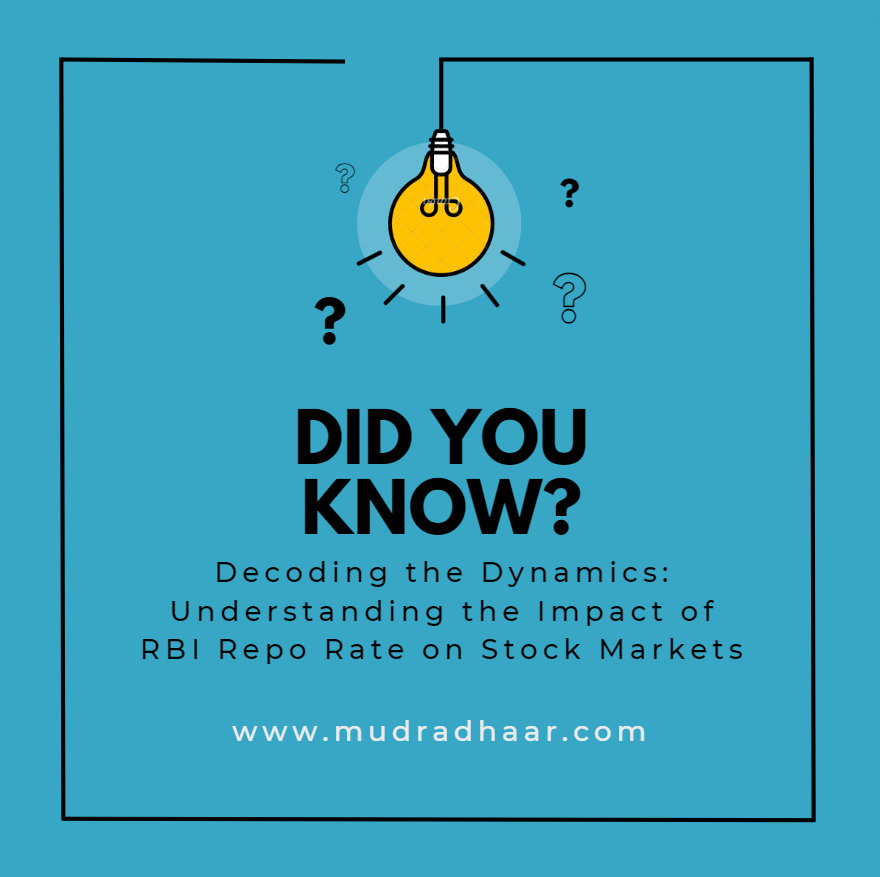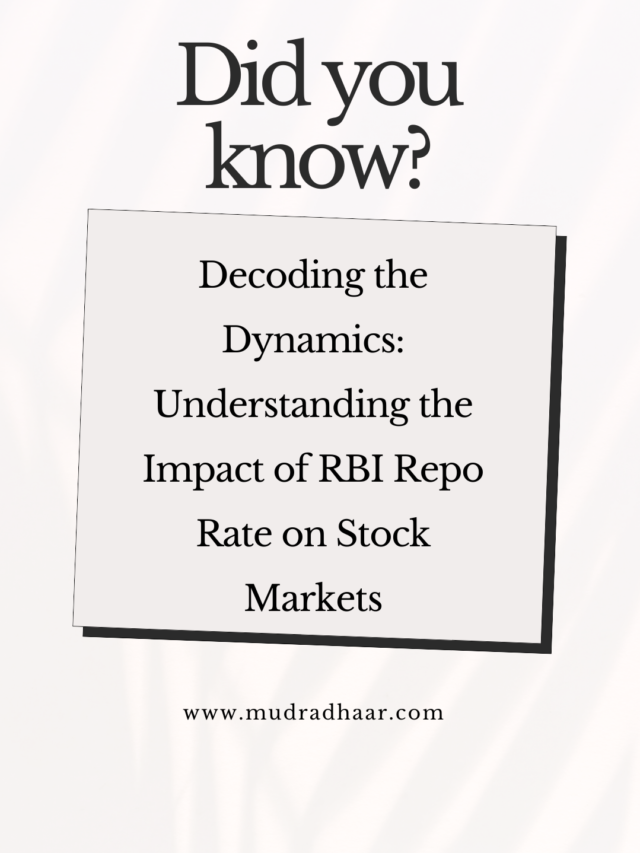In the intricate web of economic mechanisms, few levers hold as much sway over market dynamics as the RBI repo rate. As the heartbeat of India’s monetary policy, the repo rate set by the Reserve Bank of India serves as a compass guiding the nation’s financial landscape. With each adjustment, whether a cut or hike, this benchmark interest rate sends ripples through the economy, touching everything from borrowing costs to investor sentiment. In this blog, we delve into the nuances of the RBI repo rate, unraveling its significance and exploring the far-reaching implications it holds for businesses, consumers, and investors alike also we will understand the impact of RBI repo rate in stock markets. Join us on a journey through the intricacies of monetary policy as we uncover the profound impact of the RBI repo rate on India’s financial ecosystem.
Introduction: In the fast-paced world of finance, where every decimal point and policy tweak can send shockwaves through markets, few instruments wield as much influence as the RBI repo rate. If you’ve ever found yourself scratching your head at the buzz surrounding this seemingly cryptic term, fear not you’re not alone. In this blog, we’re peeling back the layers of jargon to demystify the RBI repo rate, unravel its significance, and explore how it shapes India’s economic landscape. So, grab a cup of chai, settle in, and let’s embark on a journey to decode the heartbeat of India’s monetary policy.
What is the RBI Repo Rate? Let’s start with the basics. The RBI repo rate, short for repurchase rate, is the interest rate at which the Reserve Bank of India lends money to commercial banks for short-term periods. Think of it as the cost of borrowing for banks when they need funds to meet their daily liquidity requirements. When the repo rate changes whether up, down, or sideways – it sets off a domino effect that reverberates throughout the economy.
Why Does It Matter? You might be wondering, “Why should I care about the RBI repo rate?” Well, buckle up, because here’s where things get interesting. The repo rate is like the conductor of an orchestra, orchestrating the flow of credit, inflation, and economic growth. When the RBI raises the repo rate, it’s like tapping the brakes on borrowing, making loans more expensive for businesses and consumers alike. Conversely, when the repo rate is cut, it’s akin to hitting the accelerator, stimulating borrowing and spending to fuel economic expansion.
Impact on Borrowing Costs: Now, let’s zoom in on how changes in the repo rate affect you and me the borrowers. Picture this: You’re in the market for a home loan or a shiny new car. When the RBI slashes the repo rate, banks follow suit by lowering their lending rates. Suddenly, that dream home or sleek ride becomes a lot more affordable, thanks to lower borrowing costs. On the flip side, if the repo rate climbs, brace yourself for higher interest payments on loans, putting a dent in your budget.
Inflation and Economic Growth: Inflation – the silent ninja lurking in the shadows, silently eroding purchasing power and wreaking havoc on economies. Here’s where the RBI repo rate swoops in as a valiant protector. By tweaking the repo rate, the RBI aims to keep inflation in check, striking a delicate balance between price stability and economic growth. A lower repo rate stimulates spending, driving up demand for goods and services, but also risks stoking inflationary pressures. Conversely, a higher repo rate can help tame inflation but may also put the brakes on economic expansion.
Investor Sentiment and Stock Markets: Ah, the stock market a rollercoaster ride of highs and lows, fueled by investor sentiment and market dynamics. The RBI repo rate plays a pivotal role in shaping this adrenaline-fueled arena. When the central bank cuts rates, it’s like throwing fuel on the stock market fire, boosting investor confidence and sending stock prices soaring. On the other hand, a rate hike can send shockwaves through markets, triggering sell-offs as investors brace for tighter liquidity conditions. We will explain this
We’ll delve into the intricate details surrounding the impact of changes in the RBI repo rate on the stock market. With a keen focus on deciphering the intricacies of monetary policy and its ripple effects, we aim to provide a comprehensive understanding of how shifts in the repo rate can influence stock prices and investor behavior. Stay tuned as we unravel this pivotal relationship and explore the implications for market participants seeking to navigate fluctuations in interest rates.
We have understand that Reserve Bank of India (RBI) repo rate is the rate at which the RBI lends money to commercial banks against the collateral of government securities. Changes in the repo rate by the RBI have various impacts on the stock market:
- Interest Rates and Cost of Capital: A change in the repo rate influences interest rates in the economy. When the repo rate is decreased, commercial banks can borrow at a lower cost, leading to lower interest rates in the economy. Lower interest rates reduce the cost of capital for companies, making borrowing cheaper and potentially stimulating investment. This can lead to an increase in stock prices as companies expand their operations and profitability.
- Investor Sentiment: Changes in the repo rate can affect investor sentiment. A decrease in the repo rate typically signals accommodative monetary policy, which can boost investor confidence in the economy’s growth prospects. This positive sentiment may lead to increased investment in stocks, contributing to higher stock prices.
- Cost of Borrowing: Lower repo rates can result in cheaper borrowing costs for companies. This can lead to increased borrowing for expansion or investment purposes, which may positively impact stock prices as companies grow and potentially generate higher profits.
- Impact on Financial Sector Stocks: Changes in the repo rate can have a significant impact on financial sector stocks, particularly banks and non-banking financial companies (NBFCs). Lower repo rates generally reduce the cost of funds for these institutions, potentially leading to higher profitability and stock prices.
- Exchange Rate Effects: Changes in interest rates, including the repo rate, can influence currency exchange rates. Lower repo rates may lead to a depreciation of the domestic currency, which can benefit export-oriented companies but may increase the cost of imported goods. This currency effect can indirectly impact stock prices, especially for companies with significant exposure to international trade.
- Market Expectations: Stock prices often react to market expectations regarding future changes in interest rates. Anticipation of a repo rate cut or hike can influence investor behavior and stock prices even before the actual announcement by the RBI.
When does the Reserve Bank of India (RBI) typically announce changes to the repo rate?
The Reserve Bank of India (RBI) typically announces its monetary policy decisions, including changes to the repo rate, during its Monetary Policy Committee (MPC) meetings. The RBI usually holds these meetings every month, but the exact timing can vary depending on economic conditions and other factors.
The RBI announces the dates of its MPC meetings well in advance, and these announcements are closely followed by market participants, economists, and the general public. The decision on whether to change the repo rate, keep it unchanged, or make other monetary policy adjustments is made during these meetings.
Once the MPC meeting concludes, the RBI Governor holds a press conference to announce the monetary policy decision, including any changes to the repo rate, reverse repo rate, and other policy rates, as well as provide insights into the central bank’s rationale behind the decision.
To know the exact date of the next MPC meeting and subsequent announcements of the repo rate, it’s advisable to check the official website of the Reserve Bank of India by clicking here.
Current Repo Rate is 6.5% as announce by RBI in a press release on 08-February-2024 and the next meeting of the MPC is scheduled during April 3 to 5, 2024.
To open an account with Zerodha and receive 100% reimbursement of account opening charges from me, click here:
For any further queries regarding trading, investments, or other related matters, please feel free to contact us.


